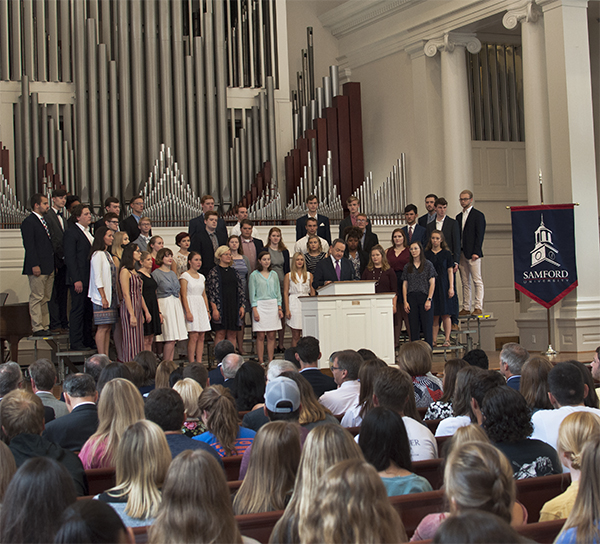
Samford University rededicated four campus facilities in a special worship service Aug. 30. The service, in the renovated A. Hamilton Reid Chapel, brought together faculty, students, administrators, trustees, local officials and representatives of the companies that completed the $13.8 million renovation projects. In addition to Reid Chapel, the rededication included Robert I. Ingalls Hall, Percy Pratt Burns Hall and James Horton Chapman Hall.
The renovations addressed the developing needs of students and faculty, and made possible the most significant physical reorganization of Howard College of Arts and Sciences since it moved to this campus from Birmingham’s East Lake community in 1957.
Burns Hall and Chapman Hall are the new homes for the Office of Spiritual Life and the academic departments of religion, history, philosophy and classics.
Ingalls Hall is now home to the academic departments of political science, geography and sociology, English and psychology. The renovation of Ingalls Hall will continue through the fall semester to create space for expanded offices for Admission and Student Financial Services.
“Welcome to your new home,” said Samford Board of Trustees chairman Tim Vines as he opened the service.
When Samford president Andrew Westmoreland spoke, he celebrated not only the rededication of the facilities, but also the leadership and supporters of the $300 million Forever Samford campaign, which is now halfway to its goal. "These generous investments enable us to make progress such as we celebrate today," Westmoreland said.
Minister to Students April Robinson also addressed the theme of generosity in her scripture lesson and sermon. The 1993 alumna and longtime employee reflected on the names on the buildings she has known for half her life, which she described as “arrows pointing us toward faithful perseverance, brass-lettered reminders of the difference faith in God and service to others can make in the world.”
Robinson reminded the standing-room-only audience of important instructions in the book of Hebrews, meant to encourage weary believers–to praise God, to do good and to share what we have. The service celebrated these instructions in the context of the building rededication, but Robinson encouraged attendees to take them to heart as they returned to their classrooms and dorms and offices. “Each of us will choose, with every action, whether or not we will amplify and multiply the faithful witness of those who have gone before us,” Robinson said. “I urge you to today to rededicate yourselves, as we rededicate these spaces, to the person and purpose of Christ.”
Other speakers at the service included SGA Chaplain Lucy Kate Green and Howard College of Arts and Sciences dean Tim Hall, who offered thanks on behalf of the college’s faculty to all involved in the renovations. Hall and Green led a prayer of dedication that echoed Robinson’s call for personal rededication.
Music for the service was conducted by Eric Mathis, associate dean of the School of the Arts, and included University Organist Frederick T. Teardo and the Samford University A Cappella Choir under the direction of Philip L. Copeland, professor and director of choral activities. Homewood Chamber of Commerce sponsored the official ribbon cutting.
Watch the full rededication ceremony.

